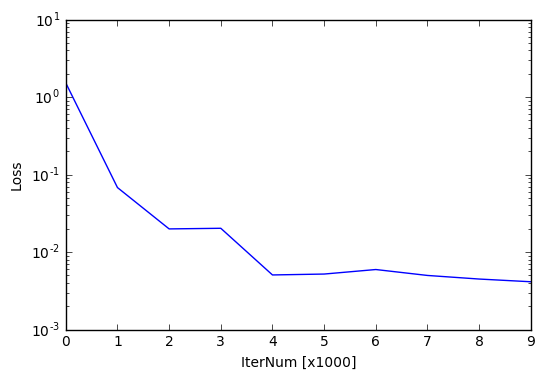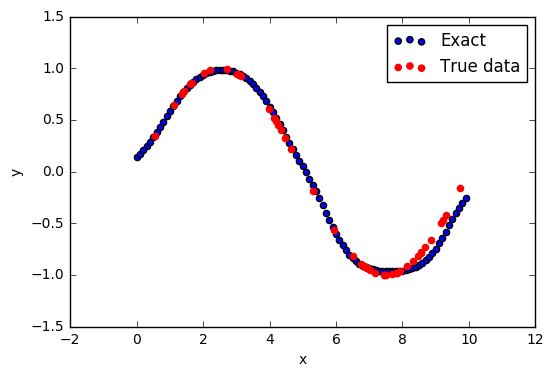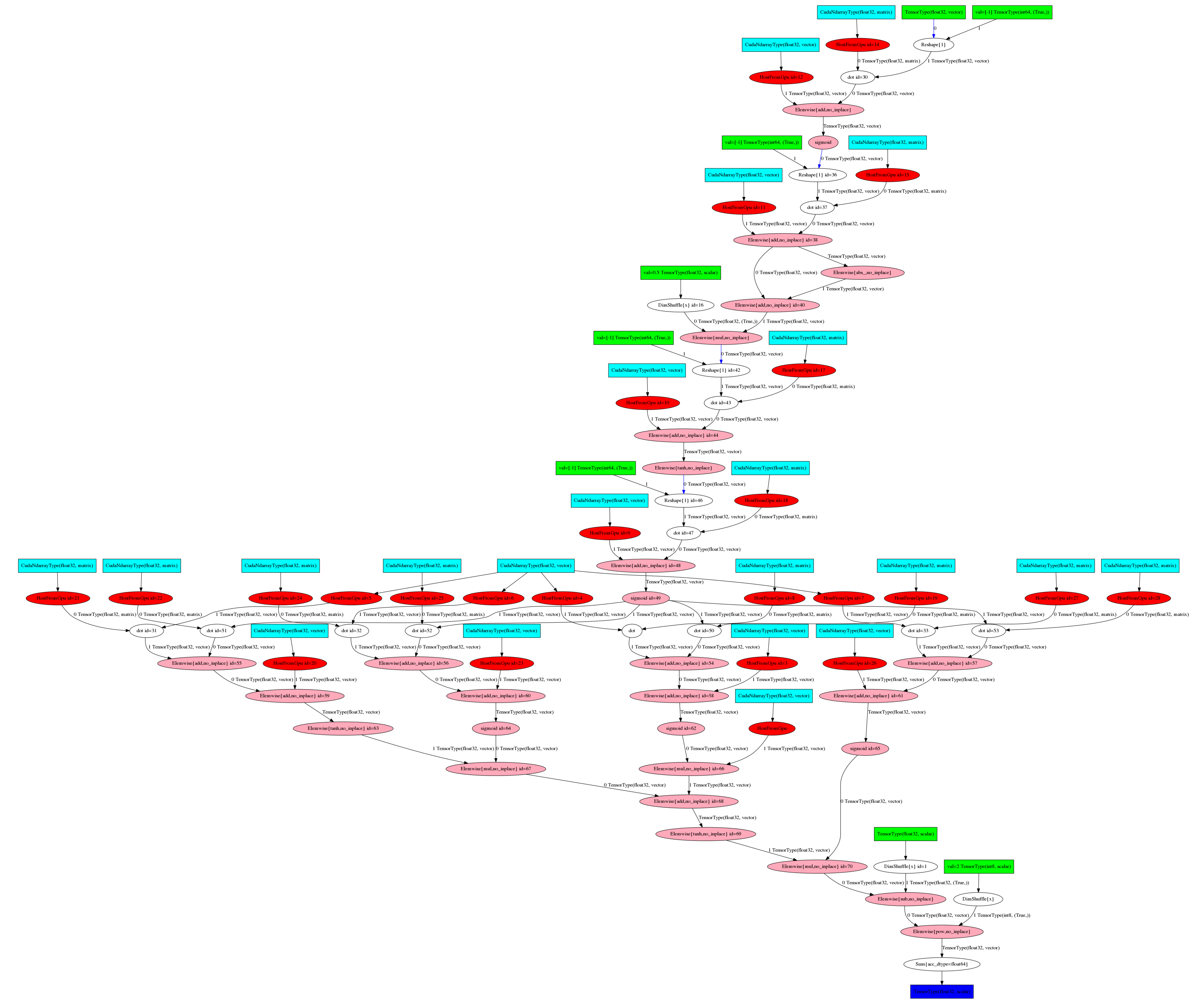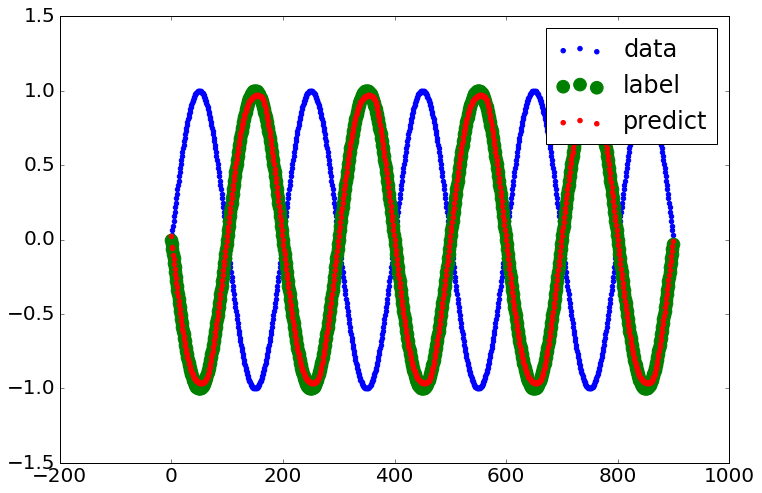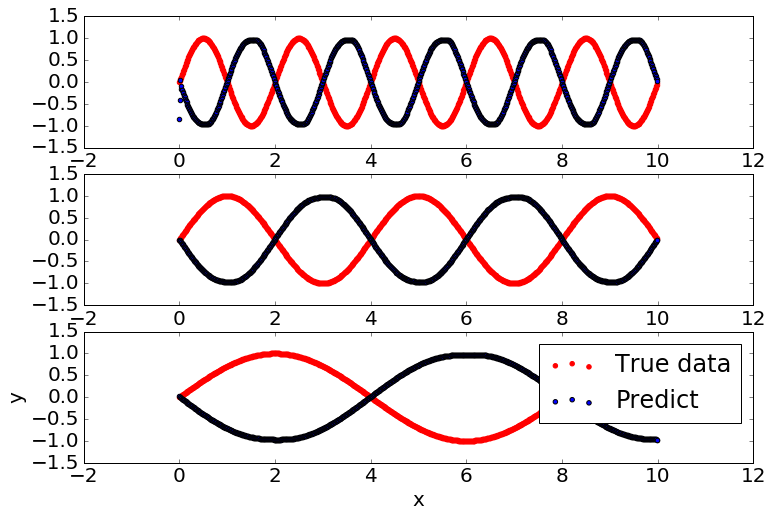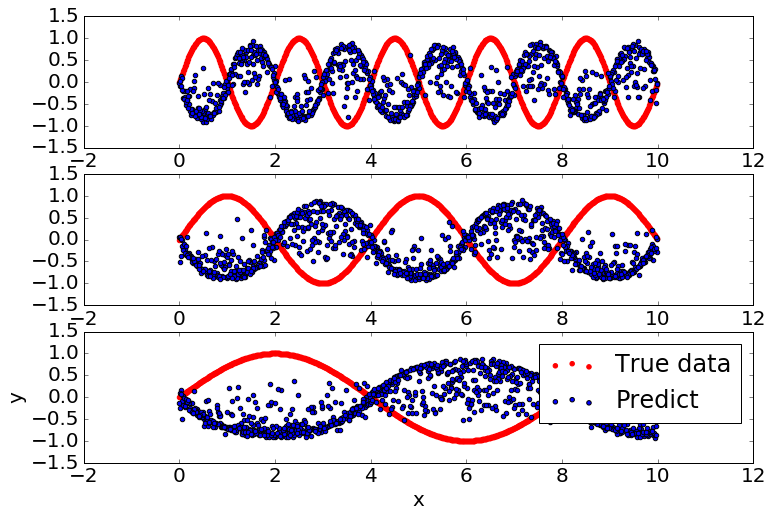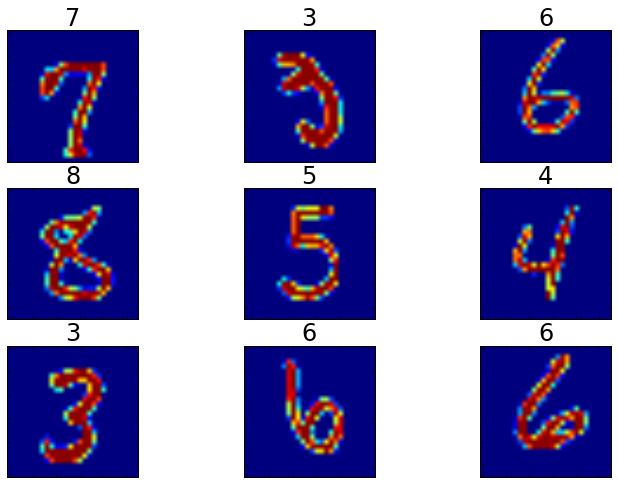2017.9.16追記.
最近は少しupgradeしました。
https://github.com/uyuutosa/Optimizer_with_theano
また、neuralstyleをコピペで試せる様にしました。
http://qiita.com/uyuutosa/items/09557f2f99e77a1b9cc2
ご参考まで。
Pythonで自作のディープラーニングモジュールを作りました(途中)。自身の勉強用です。
名前は何の捻りもないオプティマイザーです。
少ない打鍵数でネットワークがかけることを目指しています。
内部ではtheanoを用いてますが、Define by Run なchainerのほうが上位互換な気がするので、
chainerに変えるかもしれません。
記事の最後にプログラムを記載します。
LSTMとTaylorの実装は怪しいです。
使用例
Kerasの様に芋づる式にネットワークを書けるようにしています。ここでは、サインカーブを正解値として3層ネットワークにより推定します。
# データとラベルの定義 :サインカーブ
x_arr = random.rand(50).astype(theano.config.floatX) * 10
y_arr = sin(x_arr / 5. * pi)
# ネットワークの構築
o = optimizer(x_arr, y_arr)
o = o.taylor(1,6)\ # 1層目:(自称)テイラー展開層
.tanh()\ # tanhの活性化関数
.dense(1)\ # 2層目:全結合層
.loss(alpha=0.1)\ # 損失関数の定義(学習率0.1)
.optimize() # 最適化
optimizeすると以下のoutputが出てきます。
loss: 1.51645341078
loss: 0.0678153863793
loss: 0.0198567226285
loss: 0.0202341528014
loss: 0.00505698460546
loss: 0.00519401907162
loss: 0.00594055800437
loss: 0.00498228924313
loss: 0.0044779176335
loss: 0.00413105668256
出力をview()でグラフで
o.view()
正解と推定の結果は以下のように成ります。学習したネットワークを用いて推定するには、pred()を使います。
plt.scatter(arange(0,10,0.1), o.pred(arange(0,10,0.1)), label="Exact")
plt.scatter(x_arr, y_arr, color="r", label="True data")
plt.xlabel("x");plt.ylabel("y")
plt.legend()
plt.show()
計算グラフの表示
例えば、以下のような謎のネットワーク
o = optimizer(x_arr, y_arr)
o = o.dense(1).sigmoid()\
.dense(2).relu()\
.dense(3).tanh()\
.dense(4).sigmoid()\
.lstm()\
.loss()
を以下のメソッド
o.view_graph()
で可視化します。
以下のように成ります。
LSTM
再帰的な構造が単純なサインカーブフィッティングにどのように効いてくるのか不明瞭ですが、試してみました。
arr = arange(0, 10., 0.01).astype(theano.config.floatX)
y_arr = sin(arr[100:] * pi)
x_arr = sin(arr[:-100] * pi)
o = optimizer(x_arr, y_arr)
o = o.lstm().loss().optimize()
sin波がデータで、それより$\pi$位相をずらしたものがラベルです。
大体lossが下がったらCtrl-cで切ることができます。
結果は、以下になります。
plt.scatter(arange(x_arr.size), x_arr, color="b")
plt.scatter(arange(x_arr.size), o.pred(x_arr), color="r")
plt.scatter(arange(x_arr.size), o.y_arr, color="g")
dataに対してlabelはひっくり返っています。predictがlabelとほぼ一致したのでうまくいきました。うまくいったものだけ載せてます。
きれいに学習できたので、異なる周波数で推定してみます。
arr = arange(0,10,0.01)
plt.subplot(311)
data = sin(arr * pi)
plt.scatter(arr, data, color="r", label="True data")
plt.scatter(arr, o.pred(data), label="Predict")
plt.subplot(312)
data = sin(arr / 2 * pi)
plt.scatter(arr, data, color="r", label="True data")
plt.scatter(arr, o.pred(data), label="Predict")
plt.subplot(313)
data = sin(arr / 4 * pi)
plt.scatter(arr, data, color="r", label="True data")
plt.scatter(arr, o.pred(data), label="Predict")
plt.xlabel("x");plt.ylabel("y")
plt.legend()
plt.show()
以下のようになりました。
学習データと異なる周波数でもきれいに反転しています。
学習器にはデータを左から右に入れています。LSTMはリカレントな構造を持っているので、この推定結果は入力の順番に依存するはず、と思ったので、上のプログラムにrandom.shuffle(arr)をたして学習器にデータを入れる順番をランダムにしてみました。
arr = arange(0,10,0.01)
random.shuffle(arr)
# arr = random.rand(1000) * 10
plt.subplot(311)
data = sin(arr * pi)
plt.scatter(arr, data, color="r", label="True data")
plt.scatter(arr, o.pred(data), label="Predict")
plt.subplot(312)
data = sin(arr / 2 * pi)
plt.scatter(arr, data, color="r", label="True data")
plt.scatter(arr, o.pred(data), label="Predict")
plt.subplot(313)
data = sin(arr / 4 * pi)
plt.scatter(arr, data, color="r", label="True data")
plt.scatter(arr, o.pred(data), label="Predict")
plt.xlabel("x");plt.ylabel("y")
plt.legend()
plt.show()
結果はこの通りです。
低周波数は再現できてますが、ノイズのように高周波が目立っています。やはり順番が大事みたいですね。
MNIST
全結合
いくつかのデータセットをset_datasets()にて設定できます。
o = optimizer(n_batch=500)
o.set_datasets("mnist", is_one_hot=False)
o = o.dense(10).loss_softmax_cross_entropy().opt_sgd(0.000001).optimize(100000,10000)
import pylab as p
for n in range(9):
idx = random.randint(0,59999)
p.subplot(331 + n)
p.tick_params(labelbottom="off")
p.tick_params(labelleft="off")
p.title(o.pred_func(o.x_train_arr[idx:idx+1]).argmax(axis=1)[0])
p.imshow(o.x_train_arr[idx:idx+1].reshape(28,28))
出力
Iter. 0: loss = 2.3025851249694824
Iter. 10000: loss = 0.3245639503002167
Iter. 20000: loss = 0.22792282700538635
KeyboardInterrupt
CNN
o = optimizer(n_batch=5)
o.set_datasets("mnist", is_one_hot=False)
# o = o.reshape((n_batch,1,28,28)).conv2d(kshape=(4,1,24,24)).relu().pool()
o = o.reshape((1, 28, 28))\
.conv_and_pool(8, 20, 20)\
.conv_and_pool( 4, 5, 5).sigmoid()
o = o.flatten().dropout(0.5).dense(10).loss_softmax_cross_entropy()
o = o.opt_Adam(0.008).optimize(10000000,1000)
コード
import theano
import theano.tensor as T
import theano.tensor.nnet as nnet
import theano.tensor.signal as signal
import numpy as np
import matplotlib.pyplot as plt
import copy as cp
from theano.printing import pydotprint
from PIL import Image
import os
import matplotlib as mpl
from theano.tensor.shared_randomstreams import RandomStreams
from sklearn.datasets import *
from sklearn.datasets import fetch_mldata
from sklearn.cross_validation import train_test_split
mpl.rc("savefig", dpi=1200)
%config InlineBackend.rc = {'font.size': 20, 'figure.figsize': (12.0, 8.0),'figure.facecolor': 'white', 'savefig.dpi': 72, 'figure.subplot.bottom': 0.125, 'figure.edgecolor': 'white'}
%matplotlib inline
class optimizer:
def __init__(self, x_arr=None, y_arr=None,
out=None, thetalst=None, nodelst=None,
test_size=0.1, n_batch=500):
self.n_batch = theano.shared(int(n_batch))
if x_arr is not None and y_arr is not None:
self.set_data(x_arr, y_arr, test_size)
self.set_variables()
self.thetalst = [] #if thetalst is None else thetalst
self.n_view = None
self.updatelst = []
self.tmplst = []
def set_data(self, x_arr, y_arr, test_size=0.1):
self.x_train_arr, \
self.x_test_arr,\
self.y_train_arr,\
self.y_test_arr,\
= train_test_split(x_arr.astype(theano.config.floatX),
y_arr.astype(theano.config.floatX),
test_size = test_size)
self.nodelst = [[int(np.prod(self.x_train_arr.shape[1:]))]] # if nodelst is None else nodelst
def set_variables(self):
if self.n_batch.get_value() > self.x_train_arr.shape[0]:
self.n_batch.set_value(int(self.x_train_arr.shape[0]))
self.n_data = self.x_train_arr.shape[0]
n_xdim = self.x_train_arr.ndim
n_ydim = self.y_train_arr.ndim
if n_xdim == 0:
self.x = T.scalar()
if n_xdim == 1:
self.x_train_arr = self.x_train_arr[:,None]
self.x_test_arr = self.x_test_arr[:,None]
self.x = T.matrix()
elif n_xdim == 2:
self.x = T.matrix()
elif n_xdim == 3:
self.x = T.tensor3()
else:
self.x = T.tensor4()
if n_ydim == 0:
self.y = T.scalar()
if n_ydim == 1:
self.y_train_arr = self.y_train_arr[:,None]
self.y_test_arr = self.y_test_arr[:,None]
self.y = T.matrix()
elif n_ydim == 2:
self.y = T.matrix()
elif n_ydim == 3:
self.y = T.tensor3()
else:
self.y = T.tensor4()
self.out = self.x #if out is None else out
self.batch_shape_of_C = T.concatenate([T.as_tensor([self.n_batch]), theano.shared(np.array([3]))], axis=0)
def set_datasets(self, data="mnist", data_home="data_dir_for_optimizer", is_one_hot=True):
if data == "mnist":
data_dic = fetch_mldata('MNIST original', data_home=data_home)
if is_one_hot == True:
idx = data_dic["target"]
arr = np.zeros((idx.shape[0],10)).flatten()
arr[idx.flatten().astype(int) + np.arange(idx.shape[0]) * 10] = 1
data_dic["target"] = arr.reshape(idx.shape[0], 10)
elif data == "boston":
data_dic = load_boston()
elif data == "digits":
data_dic = load_digits()
elif data == "iris":
data_dic = load_iris()
elif data == "linnerud":
data_dic = load_linnerud()
elif data == "xor":
data_dic = {"data": np.array([[0,0], [0,1], [1,0], [1,1]]),##.repeat(20, axis=0),
"target": np.array([0,1,1,0])}#.repeat(20, axis=0)}
#data_dic = {"data": np.array([[0,0], [0,1], [1,0], [1,1]]).repeat(20, axis=0),
# "target": np.array([0,1,1,0]).repeat(20, axis=0)}
elif data == "serial":
data_dic = {"data": np.array(np.arange(20).reshape(5,4)).repeat(20, axis=0),
"target": np.arange(5).repeat(20, axis=0)}
elif data == "sin":
data_dic = {"data": np.arange(0,10,0.01)[:,None],
"target": np.sin(np.arange(0,10,0.01) * np.pi)}
self.set_data(data_dic["data"], data_dic["target"])
self.set_variables()
def copy(self):
return cp.copy(self)
def update_node(self, n_out):
self.nodelst = self.nodelst + [n_out]
def get_curr_node(self):
return list(self.nodelst[-1])
def dropout(self, rate=0.5, seed=None):
obj = self.copy()
srng = RandomStreams(seed)
obj.out = T.where(srng.uniform(size=obj.out.shape) > rate, obj.out, 0)
return obj
def dense(self, n_out):
obj = self.copy()
n_in = obj.get_curr_node()[-1]
#theta = theano.shared(np.random.rand(n_in, n_out).astype(theano.config.floatX))
#b = theano.shared(np.random.rand(n_out).astype(theano.config.floatX))
theta = theano.shared(np.zeros((n_in, n_out)).astype(theano.config.floatX))
#b = theano.shared(np.zeros((n_out)).astype(theano.config.floatX))
b = theano.shared(np.random.rand(1).astype(dtype=theano.config.floatX)[0])
obj.out = obj.out.dot(theta) + b
#obj.out = theta.dot(obj.out.flatten())+b
obj.thetalst += [theta,b]
obj.update_node([n_out])
return obj
def lstm(self):
obj = self.copy()
curr_shape = obj.get_curr_node()
n_in = n_out = curr_shape[-1]
#batch_shape_of_h = T.concatenate(
#batch_shape_of_C = T.concatenate(, axis=0)
# h = T.ones(theano.sharedl())
h = T.zeros([obj.n_batch, *curr_shape], dtype=theano.config.floatX)
C = T.zeros([obj.n_batch, n_out], dtype=theano.config.floatX)
Wi = theano.shared(np.random.rand(n_in, n_out).astype(theano.config.floatX))
Wf = theano.shared(np.random.rand(n_in, n_out).astype(theano.config.floatX))
Wc = theano.shared(np.random.rand(n_in, n_out).astype(theano.config.floatX))
Wo = theano.shared(np.random.rand(n_in, n_out).astype(theano.config.floatX))
bi = theano.shared(np.random.rand(n_out).astype(theano.config.floatX))
bf = theano.shared(np.random.rand(n_out).astype(theano.config.floatX))
bc = theano.shared(np.random.rand(n_out).astype(theano.config.floatX))
bo = theano.shared(np.random.rand(n_out).astype(theano.config.floatX))
Ui = theano.shared(np.random.rand(n_in, n_out).astype(theano.config.floatX))
Uf = theano.shared(np.random.rand(n_in, n_out).astype(theano.config.floatX))
Uc = theano.shared(np.random.rand(n_in, n_out).astype(theano.config.floatX))
Uo = theano.shared(np.random.rand(n_in, n_out).astype(theano.config.floatX))
i = nnet.sigmoid(obj.out.dot(Wi) + h.dot(Ui) + bi)
C_tilde = T.tanh(obj.out.dot(Wc) + h.dot(Uc) + bc)
f = nnet.sigmoid(obj.out.dot(Wf) + h.dot(Uf) + bf)
tmp = (i * C_tilde + f * C).reshape(C.shape)
obj.tmplst += [(C, tmp)]
C = tmp
o = nnet.sigmoid(obj.out.dot(Wo) + h.dot(Uo) + bo)
tmp = (o * T.tanh(C)).reshape(h.shape)
obj.tmplst += [(h, tmp)]
obj.out = tmp
obj.thetalst += [Wi, bi, Ui, Wf, bf, Uf, Wc, bc, Uc, Wo, bo, Uo]
obj.update_node([n_out])
return obj
def conv2d(self, kshape=(1,1,3,3), mode="full", reshape=None):
obj = self.copy()
n_in = obj.get_curr_node()
if reshape is not None:
obj.out = obj.out.reshape(reshape)
n_in = reshape
if obj.out.ndim == 2:
obj.out = obj.out[None, :, :]
n_in = (1, n_in[1], n_in[2])
elif obj.out.ndim == 1:
obj.out = obj.out[None, None, :]
n_in = [1, 1] + list(n_in)
if mode == "full":
n_out = [kshape[0], n_in[-2] + (kshape[-2] - 1), n_in[-1] + (kshape[-2] - 1)]
#n_out = [n_in[0], kshape[0], n_in[-2] + (kshape[-2] - 1), n_in[-1] + (kshape[-2] - 1)]
elif mode == "valid":
n_out = [kshape[0], n_in[-2] - (kshape[-2] - 1), n_in[-1] - (kshape[-2] - 1)]
theta = theano.shared(np.random.rand(*kshape).astype(dtype=theano.config.floatX))
b = theano.shared(np.random.rand(1).astype(dtype=theano.config.floatX)[0])
obj.b = b
obj.out = nnet.conv2d(obj.out, theta, border_mode=mode) + b
obj.thetalst += [theta, b]
obj.update_node(n_out)
return obj
def conv_and_pool(self, fnum, height, width, mode="full", ds=(2,2)):
obj = self.copy()
n_in = obj.get_curr_node()
kshape = (fnum, n_in[0], height, width)
n_batch = obj.n_batch.get_value()
obj = obj.conv2d(kshape=kshape)
#.reshape((n_batch, np.array(n_in, dtype=int).sum()))\
if mode == "full":
obj = obj.relu().pool(ds=ds)
n_in = obj.get_curr_node()
obj = obj.reshape((kshape[0], *n_in[-2:]))
#obj = obj.reshape((kshape[0], M[0]+(m[0]-1),M[1]+(m[1]-1)))
elif mode == "valid":
n_in = obj.get_curr_node()
obj = obj.reshape((kshape[0], *n_in[-2:]))
return obj
def pool(self, ds=(2,2)):
obj = self.copy()
n_in = obj.get_curr_node()
obj.out = signal.pool.pool_2d(obj.out, ds=ds, ignore_border=True)
n_in[-2] = n_in[-2] // ds[0] #+ (1 if (n_in[-2] % ds[0]) else 0)
n_in[-1] = n_in[-1] // ds[1] #+ (1 if (n_in[-1] % ds[1]) else 0)
obj.update_node(n_in)
#print(obj.nodelst)
return obj
def mean(self, axis):
obj = self.copy()
n_in = obj.get_curr_node()
obj.out = obj.out.mean(axis=axis)
obj.update_node(np.ones(n_in).mean(axis=axis).shape)
return obj
def reshape(self, shape):
obj = self.copy()
obj.out = obj.out.reshape([obj.n_batch, *shape])
obj.update_node(shape)
return obj
def reshape_(self, shape):
obj = self.copy()
obj.out = obj.out.reshape(shape)
obj.update_node(shape[1:])
return obj
def flatten(self):
obj = self.copy()
n_in = obj.get_curr_node()
last_ndim = np.array(n_in).prod()
obj.out = obj.out.reshape((obj.n_batch, last_ndim))
obj.update_node([last_ndim])
return obj
def taylor(self, M, n_out):
obj = self.copy()
n_in = int(np.asarray(obj.get_curr_node()).sum())
x_times = T.concatenate([obj.out, T.ones((obj.n_batch, 1)).astype(theano.config.floatX)],axis=1)
for i in range(M-1):
idx = np.array([":,"]).repeat(i+1).tolist()
a = dict()
exec ("x_times = x_times[:," + "".join(idx) + "None] * x_times", locals(), a)
x_times = a["x_times"]
x_times = x_times.reshape((obj.n_batch, -1))
#x_times = x_times.reshape(self.n_batch, (n_in+1) ** M)
theta = theano.shared(np.ones(((n_in+1) ** M, n_out)).astype(theano.config.floatX))
obj.theta = theano.shared(np.ones(((n_in+1) ** M, n_out)).astype(theano.config.floatX))
#theta = theano.shared(np.random.rand(n_out, (n_in+1) ** M).astype(theano.config.floatX))
obj.out = x_times.dot(theta.astype(theano.config.floatX))
obj.thetalst += [theta]
obj.update_node([n_out])
return obj
def relu(self, ):
obj = self.copy()
obj.out = nnet.relu(obj.out)
return obj
def tanh(self, ):
obj = self.copy()
obj.out = T.tanh(obj.out)
return obj
def sigmoid(self, ):
obj = self.copy()
obj.out = nnet.sigmoid(obj.out)
return obj
def softmax(self, ):
obj = self.copy()
obj.out = nnet.softmax(obj.out)
return obj
def loss_msq(self):
obj = self.copy()
obj.loss = T.mean((obj.out - obj.y) ** 2)
return obj
def loss_cross_entropy(self):
obj = self.copy()
obj.loss = -T.mean(obj.y * T.log(obj.out + 1e-4))
return obj
def loss_softmax_cross_entropy(self):
obj = self.copy()
obj.out = nnet.softmax(obj.out)
tmp_y = T.cast(obj.y, "int32")
obj.loss = -T.mean(T.log(obj.out)[T.arange(obj.y.shape[0]), tmp_y.flatten()])
obj.out = obj.out.argmax(axis=1)
#obj.out2 = obj.out.argmax(axis=1)
#obj.out2 = obj.out[T.arange(obj.y.shape[0]), tmp_y.flatten()]
# obj.loss2 = T.log(obj.out)[T.arange(obj.y.shape[0]), tmp_y.flatten()]
return obj
def opt_sgd(self, alpha=0.1):
obj = self.copy()
obj.updatelst = []
for theta in obj.thetalst:
obj.updatelst += [(theta, theta - (alpha * T.grad(obj.loss, wrt=theta)))]
obj.updatelst += obj.tmplst
return obj
def opt_RMSProp(self, alpha=0.1, gamma=0.9, ep=1e-8):
obj = self.copy()
obj.updatelst = []
obj.rlst = [theano.shared(x.shape).astype(theano.config.floatX) for x in obj.thetalst]
for r, theta in zip(obj.rlst, obj.thetalst):
g = T.grad(obj.loss, wrt=theta)
obj.updatelst += [(r, gamma * r + (1 - gamma) * g ** 2),\
(theta, theta - (alpha / (T.sqrt(r) + ep)) * g)]
obj.updatelst += obj.tmplst
return obj
def opt_AdaGrad(self, ini_eta=0.001, ep=1e-8):
obj = self.copy()
obj.updatelst = []
obj.hlst = [theano.shared(ep*np.ones(x.get_value().shape, theano.config.floatX)) for x in obj.thetalst]
obj.etalst = [theano.shared(ini_eta*np.ones(x.get_value().shape, theano.config.floatX)) for x in obj.thetalst]
for h, eta, theta in zip(obj.hlst, obj.etalst, obj.thetalst):
g = T.grad(obj.loss, wrt=theta)
obj.updatelst += [(h, h + g ** 2),
(eta, eta / T.sqrt(h+1e-4)),
(theta, theta - eta * g)]
obj.updatelst += obj.tmplst
return obj
def opt_Adam(self, alpha=0.001, beta=0.9, gamma=0.999, ep=1e-8, t=3):
obj = self.copy()
obj.updatelst = []
obj.nulst = [theano.shared(np.zeros(x.get_value().shape, theano.config.floatX)) for x in obj.thetalst]
obj.rlst = [theano.shared(np.zeros(x.get_value().shape, theano.config.floatX)) for x in obj.thetalst]
for nu, r, theta in zip(obj.nulst, obj.rlst, obj.thetalst):
g = T.grad(obj.loss, wrt=theta)
nu_hat = nu / (1 - beta)
r_hat = r / (1 - gamma)
obj.updatelst += [(nu, beta * nu + (1 - beta) * g),\
(r, gamma * r + (1 - gamma) * g ** 2),\
(theta, theta - alpha*(nu_hat / (T.sqrt(r_hat) + ep)))]
obj.updatelst += obj.tmplst
return obj
def optimize(self, n_epoch=10, n_view=1000):
obj = self.copy()
obj.dsize = obj.x_train_arr.shape[0]
if obj.n_view is None: obj.n_view = n_view
x_train_arr_shared = theano.shared(obj.x_train_arr).astype(theano.config.floatX)
y_train_arr_shared = theano.shared(obj.y_train_arr).astype(theano.config.floatX)
#rng = T.shared_randomstreams.RandomStreams(seed=0)
#obj.idx = rng.permutation(size=(1,), n=obj.x_train_arr.shape[0]).astype("int64")
#obj.idx = rng.permutation(size=(1,), n=obj.x_train_arr.shape[0])[0, 0:obj.n_batch].astype("int64")
#idx = obj.idx * 1
i = theano.shared(0).astype("int32")
idx = theano.shared(np.random.permutation(obj.x_train_arr.shape[0]))
obj.loss_func = theano.function(inputs=[i],
outputs=obj.loss,
givens=[(obj.x,x_train_arr_shared[idx[i:obj.n_batch+i],]),
(obj.y,y_train_arr_shared[idx[i:obj.n_batch+i],])],
updates=obj.updatelst,
on_unused_input='warn')
i = theano.shared(0).astype("int32")
idx = theano.shared(np.random.permutation(obj.x_train_arr.shape[0]))
obj.acc_train = theano.function(inputs=[i],
#outputs=((T.eq(obj.out2[:,None],obj.y))),
outputs=((T.eq(obj.out[:,None],obj.y)).sum().astype(theano.config.floatX) / obj.n_batch),
givens=[(obj.x,x_train_arr_shared[idx[i:obj.n_batch+i],]),
(obj.y,y_train_arr_shared[idx[i:obj.n_batch+i],])],
on_unused_input='warn')
#idx = rng.permutation(size=(1,), a=obj.x_train_arr.shape[0])#.astype("int8")
#idx = rng.permutation(size=(1,), n=500, ndim=None)[0,0:10]#.astype("int8")
c = T.concatenate([obj.x,obj.y],axis=1)
obj.test_func = theano.function(inputs=[i],
outputs=c,
givens=[(obj.x,x_train_arr_shared[idx[i:obj.n_batch+i],]),
(obj.y,y_train_arr_shared[idx[i:obj.n_batch+i],])],
on_unused_input='warn')
# obj.test_func = theano.function(inputs=[i],
# outputs=c,
# givens=[(obj.x,x_train_arr_shared[idx[i:obj.n_batch+i],]),
# (obj.y,y_train_arr_shared[idx[i:obj.n_batch+i],])],
# on_unused_input='warn')
obj.pred_func = theano.function(inputs = [obj.x],
outputs = obj.out,
updates = obj.tmplst,
on_unused_input='warn')
obj.v_loss = []
try:
for epoch in range(n_epoch):
for i in range(0,obj.dsize-obj.n_batch.get_value(),obj.n_batch.get_value()):
mean_loss = obj.loss_func(i)
print("Epoch. %s: loss = %s, acc = %s." %(epoch, mean_loss, obj.acc_train(i)))
obj.v_loss += [mean_loss]
except KeyboardInterrupt :
print ( "KeyboardInterrupt\n" )
return obj
return obj
def view_params(self):
for theta in self.thetalst:
print(theta.get_value().shape)
print(theta.get_value())
def view(self, yscale="log"):
if not len(self.v_loss):
raise ValueError("Loss value is not be set.")
plt.clf()
plt.xlabel("IterNum [x%s]" %self.n_view)
plt.ylabel("Loss")
plt.yscale(yscale)
plt.plot(self.v_loss)
plt.show()
def view_graph(self, width='100%', res=60):
path = 'examples'; name = 'mlp.png'
path_name = path + '/' + name
if not os.path.exists(path):
os.mkdirs(path)
pydotprint(self.loss, path_name)
plt.figure(figsize=(res, res), dpi=80)
plt.subplots_adjust(left=0.0, right=1.0, bottom=0.0, top=1.0, hspace=0.0, wspace=0.0)
plt.axis('off')
plt.imshow(np.array(Image.open(path_name)))
plt.show()
def pred(self, x_arr):
x_arr = np.array(x_arr).astype(theano.config.floatX)
self.n_batch.set_value(int(x_arr.shape[0]))
return self.pred_func(x_arr)
